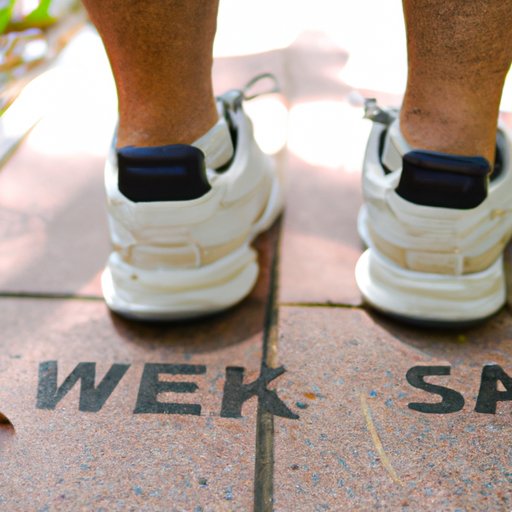Introduction
For those looking to shed a few pounds, walking and biking are two of the most popular forms of exercise. Low-impact and easy to do, they offer many benefits to people of all ages and fitness levels. In this article, we’ll explore the advantages and disadvantages of walking and biking for weight loss, examining the calorie-burning benefits, weight loss results, nutritional needs, health benefits, time commitment, and safety factors involved.
Analyzing the Calorie-Burning Benefits of Walking vs. Biking
To understand how walking and biking can help with weight loss, it’s important to consider the number of calories burned during each activity. According to Harvard Health Publishing, a person who weighs 155 pounds burns approximately 200 calories in 30 minutes of walking at a moderate pace, while the same amount of time spent biking can burn up to 400 calories. However, the type of terrain you choose to walk or bike on can make a big difference. For instance, walking on a flat surface is not as intense as walking up hills, which requires more effort and burns more calories. The same applies to biking; riding uphill is more demanding than taking a leisurely ride on a flat road.
When it comes to intensity, walking and biking can be done at different levels depending on your goals. If you’re just starting out, a slow, steady pace is recommended. As you become more fit, you can increase the speed and/or terrain difficulty to challenge yourself further. It’s also important to keep in mind that the harder you work, the more calories you’ll burn.

Examining Weight Loss Results from Different Types of Exercise
The amount of weight you’ll lose from walking or biking depends on several factors, such as frequency, duration, and intensity. Generally, it takes 3,500 calories to lose one pound, so if you want to lose a significant amount of weight, you’ll need to commit to a regular exercise routine. To achieve optimal results, the American College of Sports Medicine recommends working out for at least 150 minutes per week (or 30 minutes five times a week). This can be broken down into 10-minute increments throughout the day if needed.
It’s also important to remember that walking and biking are only part of the equation when it comes to weight loss. Eating a healthy, balanced diet is essential to achieving your goals. Eating the right foods will fuel your workouts and provide the nutrients your body needs to stay healthy. Monitoring what you eat and drink is key to successful weight loss.

Exploring the Impact of Diet and Nutrition on Walking or Biking for Weight Loss
Eating the right foods before and after a workout is crucial for maximizing the benefits of walking or biking for weight loss. Before a workout, it’s important to eat something that will give you energy, such as a banana or a handful of nuts. After a workout, refuel your body with complex carbohydrates, such as oatmeal or brown rice, as well as lean proteins, such as chicken or fish. Staying hydrated is also essential to maintaining your energy levels and preventing fatigue.
Comparing the Health Benefits of Walking vs. Biking for Weight Loss
In addition to helping with weight loss, walking and biking offer numerous health benefits. Both activities can improve cardiovascular health by strengthening the heart and lungs and decreasing blood pressure. They can also reduce stress, improve mood, and boost energy levels. Another benefit of walking and biking is that they’re low-impact exercises, which means they put less strain on the joints than other activities like running.
Assessing the Time Commitment Required for Walking or Biking to Reach Weight Loss Goals
When it comes to walking or biking for weight loss, it’s important to set realistic goals and be patient. Depending on your current fitness level and weight, it may take several weeks or months to achieve your desired results. The best way to stay motivated is to schedule regular workouts and track your progress. Keeping a journal of your accomplishments can help you stay focused on your goals.

Investigating the Safety Factors of Walking or Biking for Weight Loss
Safety is an important factor to consider when walking or biking for weight loss. If you plan to exercise outdoors, make sure to wear bright colors or reflective clothing to make yourself more visible to motorists. You should also wear comfortable shoes and carry a cell phone in case of emergency. Additionally, it’s important to always follow traffic laws and never ride or walk alone at night.
Conclusion
Walking and biking are excellent ways to get in shape and lose weight. Not only do they burn calories, but they also offer numerous health benefits, such as improved cardiovascular health and lower stress levels. When beginning a walking or biking program, it’s important to set realistic goals and monitor your progress. Eating a healthy, balanced diet and staying hydrated are also essential to achieving your desired results. With proper planning and dedication, walking or biking can be an effective way to reach your weight loss goals.


